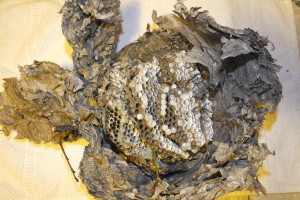
When you peel back the outer paper of a wasp nest, you find layers of hive, some dead larvae, some wasps springing to life and not much honey. Also a faint odor.
When the leaves fell off the trees in Prospect Park this fall a giant wasp nest revealed itself handing just a few feet above they busy Long Meadow sidewalk. It was already cold and rainy, so of course I decided to take some down. Didn’t get far. Just a small hunk. I put it in our stroller and headed home.
Here’s my first tip in dealing with a giant wasp nest. It might not be entirely dead. I didn’t get swarmed or even stung. But after that honeycomb spent a warm night in my apartment, a handful of zombie wasps were crawling out of their cells. I quickly cast the thing out into the cold again. So, their revival was short-lived. They didn’t even make it out.
I decided maybe I should look up my assumption the nest was an annual project and died off each year. Turns out I was mostly right–the nests of paper wasps are short-lived summer homes, Texas A&M says. Once the fall hits, nest goes into decline. The queen and some mated females go off somewhere else and hibernate. Everybody else dies. Or at least that’s how it’s supposed to work here. Though in the UK, this past year there was, in the words of the Daily Mail, a “plague of wasps” and “population explosion” because the weather extended hibernation.
I later went back to retrieve the entire nest and left it outside for a good long time before cutting into it. So far no zombie wasps after a couple days inside, but there is a slight musk to it inside its plastic bag. Inside where five layers of honeycomb. Though no real honey. This entemologist explains on YouTube that wasps do make a kind of honey, but it’s not very delicious since they eat insects instead of pollen like bees do. Imagine trying to sell the mosquito and gnat honey at the farmer’s market next to the stuff pollinated by clover or orange blossoms.
The Cornell Cooperative Extension didn’t get back to me on my odd request for their opinion on why there were live wasps in the nest. Their (much) earlier publication on wasps in New York State says there are thousands of species, but the most common is the Vespula maculata or bald-faced hornet.
I didn’t see any more of the fully formed wasps come back from the dead. There were only black carcasses slumping out of the holes they never fully escaped and brown and white larvae inside some of the still covered cells. I am pretty sure I caught cooties from the mushy brown one, but otherwise escaped unscathed.

Recent Comments